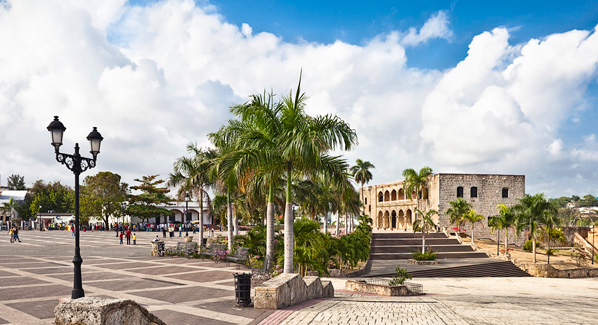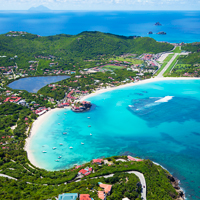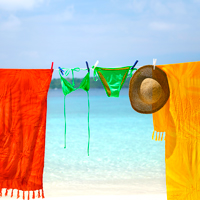Poking around a seaside village in Provence, loitering in a creperie with the Mediterranean stretching away just outside the window, browsing boutiques filled with small things that are useless—but beautiful—to be brought home. There are places in the Caribbean that evoke that same languorous vibe and have the charm and the spirit of Europe. While you won’t mistake Martinique for the Cote d’Azur or Santo Domingo for Seville, they do offer experiences—food, atmosphere and accent—that satisfy in ways a trip to the Continent never could. Plus, the beaches are a whole lot better.
Martinique
For those familiar only with the Anglophone Caribbean, Martinique is a revelation. Sure they speak French here—alongside Creole Martiniquais—but it’s the food, the architecture and the atmosphere that give it the sense of being a lost bit of Provence that somehow floated across the pond and fetched up on a reef. The narrow streets of Fort de France wind up from the bay into the hills beyond. The spire of the white cathedral punctuating the skyline; the byways lined with French Creole buildings clad in pastel wood and plaster.
No French town is complete without its fresh market, and Le Grand Marché Couvert (Covered Market) has been the focal point since 1901. Row after row of vendors offer everything from fresh melons to bois bandé—herbal Viagra. Walk a few blocks to the considerably upmarket Rue Victor Hugo, with shops that showcase the latest fashions from Paris and the French Riviera. Make time for lunch at La Cave a Vins; enter through the wine cellar before sitting in the formal dining room or, better yet, the airy atrium lined with sun-splashed trompe l’oeil murals of French vineyards. As in France, food comes first, with wine a close second, and La Cave delivers on both counts. But La Cave is by no means the only eatery that could hold its own in the mother country. Many of the local chefs came here from the Continent or were trained there, and it shows in the minute details lavished on the dishes.

Martinique’s St. Pierre was once known as “the Paris of the Caribbean.” Almost completely destroyed by a volcanic eruption in 1902, the town rebuilt, but never regained its prominence. Photo: iStock
Cross the bay from Fort de France to La Village Creole in Trois-Ilets, a bricked pedestrian promenade lined with shops and cafes. Pick out some handmade jewelry, choose a cafe for dinner and then stay for music and drinks at the Hemingway pub. Just as some of the most delightful parts of France are not in Paris, you have to get away from the tourist hustle of Fort de France to get the full experience. Le Domaine Saint Aubin on the east coast is a perfect model of the gastronomic hotels that dot the French countryside. Run by a husband- and-wife team of chef and hotelier, the hotel is known for both the food and the hospitality; the 19th century plantation house is a Creole confection. Visit La Pagerie, the childhood home of Empress Josephine, and read Napoleon’s racy letters to the love of his life. The few traces that remain of Saint-Pierre—the former capital leveled by an eruption of Mount Pele in 1902—are picturesque, like the ruined forts and abbeys you find on the Continent.
Something you won’t find in France is rhum agricole, which some would argue is the lifeblood of Martinique. Most rums are produced from molasses (sugar cane juice that’s been reduced to syrup); rhum agricole is produced from the juice itself, before it’s been boiled down. You can tour the distilleries—Clément has the old machinery to gawk at and a beautiful 19th century plantation house—and come away with a liter of heaven in a bottle. Though it may lack the flowing fields of lavender, Martinique is a fair proxy for Provence, with the added bonus of palm trees and those incredible volcanic beaches—just the place to grab a bottle of rum, settle into the shade, drink and dream. C’est merveilleux!
Santo Domingo, Dominican Republic
Founded in 1498, less than a decade after Columbus’ first voyage, Santo Domingo is the oldest surviving European city in the Western Hemisphere. Following a hurricane in 1502, the current city was carefully planned on a grid laid down by Nicolás de Ovando, the colonial governor sent from Spain. Ovando placed the city where the left bank of the Ozama River meets the Caribbean Sea, on a small rise that, once lined with fortifications, was easy to defend. While a vast metropolis has grown up around it, inside the walls of the old city, you could be in Seville, the port from which the New World fleets sailed. Narrow streets are crowded by stone buildings, their doors opening immediately onto slender sidewalks. The house of Hernán Cortés, the conqueror of Mexico, is here, along with the oldest Cathedral in the New World, Santa María la Menor. This may—or may not—be the burial place of Christopher Columbus; Seville claims him too and has DNA that strongly suggests at least some of his bones are there.
Stone walls half a millennium old encircled the city and major sections still stand. The Condé Gate on the western edge of the district marks Independence Square, with its fortifications and monuments to the country’s founders. On the southeast corner is Fortaleza Ozama, its brooding, blockish walls a stark reminder of the business of war. At the time they were built, Spain was barely 20 years removed from the reconquest of their country from the African Moors; Ovando himself fought the Moors before being posted to the New World. The walls are medieval: stout, square and devoid of ornament. Ovando’s own house is now a hotel, the original walls exposed, its graceful galleried courtyard a peaceful redoubt for relaxation and soft jazz.

The stone buildings that line Santo Domingo’s Plaza de España were once the homes of colonial-era merchants. Today, many have been converted to shops and restaurants. Photo: Laura Garca/iStock
The Alcázar Colón was built by Diego Columbus, Christopher’s son, when he was sent to replace Ovando as governor in 1509. With its pillared galleries, it echoes the Romanesque buildings of Seville and Granada. Inside are masterworks of European painting and tapestry, heavy carved furniture with simple squared lines and a trove of antiques. In front of and behind these iconic Iberian walls, the life of the city goes on as it has for hundreds of years. People relax in the shade of trees across from the cathedral, families come out to slowly stroll and couples walk hand in hand past small shops and corner bodegas. The sights and sounds are Old World, and there’s a taste of Spain in the restaurants if you know where to look. Ironically, Dominicans prefer Italian food and tasteful trattorias abound. At El Meson de la Cava, an elegant restaurant literally inside a cave, tapas are mixed with seafood and the inevitable Italian specialties. A more traditional lineup of tapas is offered at Cantábrico, with plenty of Manchego to go with the jamon, pulpo and chorizo. Fantastico.
Barbados
While the rest of the Antilles flip-flopped between owners in the great colonial chess match of the 17th and 18th centuries, Barbados has been resolutely British since the arrival of the first English colonists in 1672. Stolid, conservative and ultimately very stable, Barbados built its wealth on sugar plantations. Affluent planters constructed expansive homes of coral rock as an enduring monument to their success, and many still stand across the island, timeless capsules preserving proper English domestic architecture. The styles range from 17th century Jacobean— all the rage back home when the earliest plantations were built—to Georgian and Victorian. Only three original Jacobean mansions are left in the Western Hemisphere and two—Drax Hall and St. Nicholas Abbey—are in Barbados. Drax would look right at home on a manor in the Cotswolds.

Home to the third oldest political system within the British Commonwealth, Barbados’ historic parliament buildings are prime examples of Gothic architecture. Photo: Flavio Vallenari/iStock
Perhaps reluctant to apply the newfangled style to religious buildings until it had proved itself, Bajan churches are imposing Gothic edifices with that steady, time-tested Anglican attitude. In addition to architecture, iconic British traditions were imported intact. The national sport is cricket, while horse racing at Garrison Savannah—begun in 1845—comes in a close second. A walk down Broad in Bridgetown will remind you of the high street in any middling city in England, with the exception that the prices are all duty-free. For a dive back in time, head up to Bagatelle Great House. The gracious plantation manor was built in 1645, with a formal garden and large covered porches. Arrive in the afternoon at Chatters Tea Room for high tea, complete with fine china, cucumber sandwiches and a proper cuppa. Cheerio, then.
St. Barts
If you took the French Riviera and dropped it into the tropics—wait, they already did. It’s called St. Barthélemy. Beyond chic, St. Barts was the home away from home for Caribbean crooner Jimmy Buffet, and celebrities from both sides of the pond are seen here regularly. In part, it’s the style. The fact that St. Barts is also very expensive doesn’t hurt the exclusivity factor either. It’s a remarkable transformation for a place that didn’t have electricity until the 1960s. That came courtesy of the mayor, a Dutchman who landed his plane on a grassy field—there was no airport—and ended up buying a rocky promontory on Baie St. Jean. He built a little hideaway hotel and that hotel, Eden Rock, became a magnet for glitterati.

In the height of the season, St. Bart’s Gustavia Harbor fills with a collection of mega-yachts, giving the island one more thing in common with the French Riviera. Photo: Christian Wheatley/iStock
Across the island at Gustavia, the streets scramble up a steep hillside; small cafes with patisserie selections worthy of a Paris suburb rub elbows with elegant boutiques. While the chicness of it all is very Riviera, it’s the attitude that seals the deal: food in the Continental fashion prepped with a fanatical attention to detail and, of course, the perfect wine. There are 150 bottles in the cellar at the Eden Roc, including a $4,200 bottle of Petrus and a $7,500 Jeroboam by Cristal. Your cheeseburger in paradise will be served with brie rather than cheddar, and at $45 you hope it will be personally grilled by superstar chef Jean-Georges Vongerichten, who operates the hotel’s restaurants. Tres bon!
Curacao
Viewed from Sint Annabai (St. Anna’s Bay), the tall, narrow buildings of Willemstad’s historic Punda district could be canal houses in Amsterdam, save for their bright Easter-egg exteriors. Here as at home, the Dutch taxed homeowners by width rather than square footage, creating domino-like rows of tall, skinny houses with distinctive steeply pitched roofs and Dutch gable ends. Crossing the swinging Queen Emma pontoon bridge brings you down into the streets of Punda, where narrow byways are lined with small shops and restaurants. Sit down at a table and all around you may hear native Dutch from the many expats and islanders educated in the Netherlands, or Papiamentu, a Creole dialect of Dutch, Portuguese, Spanish, English and Amerindian. Several thousand makambas (Dutch) live in Curacao, and 40 percent of the island’s tourists are Europeans.
The food is different, too. A collection of edibles gathered from across the 18th century Dutch empire: roti and tandoori from India, rijstaffel (rice table) and bami (stir-fried noodles) from Indonesia and okra and peanuts from Africa. The foodstuffs arrived in the holds of Dutch traders, and once on shore, they evolved and blended. Keshi yena is a delicious concoction of Gouda cheese stuffed with chicken, onions, sliced olives and raisins. The best of these made it back to Amsterdam and are served there today, a gastronomic bond between the motherland and the former colony.

In Curacao, the narrow facades and multi-story floor plans of homes along Willemstad’s waterfront are reminiscent of Amsterdam, but the colors are pure Caribbean. Photo: Sara Winter/iStock
Get that grounded historic feeling from a visit to Mikve Israel-Emanuel, the oldest synagogue in the Western Hemisphere. Sephardic Jews from Portugal who came here to find freedom from persecution founded the congregation in 1651, and the synagogue was built in 1732. The floor is covered with sand to remind worshippers of the 40 years Israelites spent wandering in the desert after their escape from Egypt. There are forts as well—Amsterdam, Nassau and Beekenburg—with the expected walls mounted with cannons. The only things missing are bicycles and canal boats—that, and the long, hard winters. Muchu bunita, muchu nechi!










